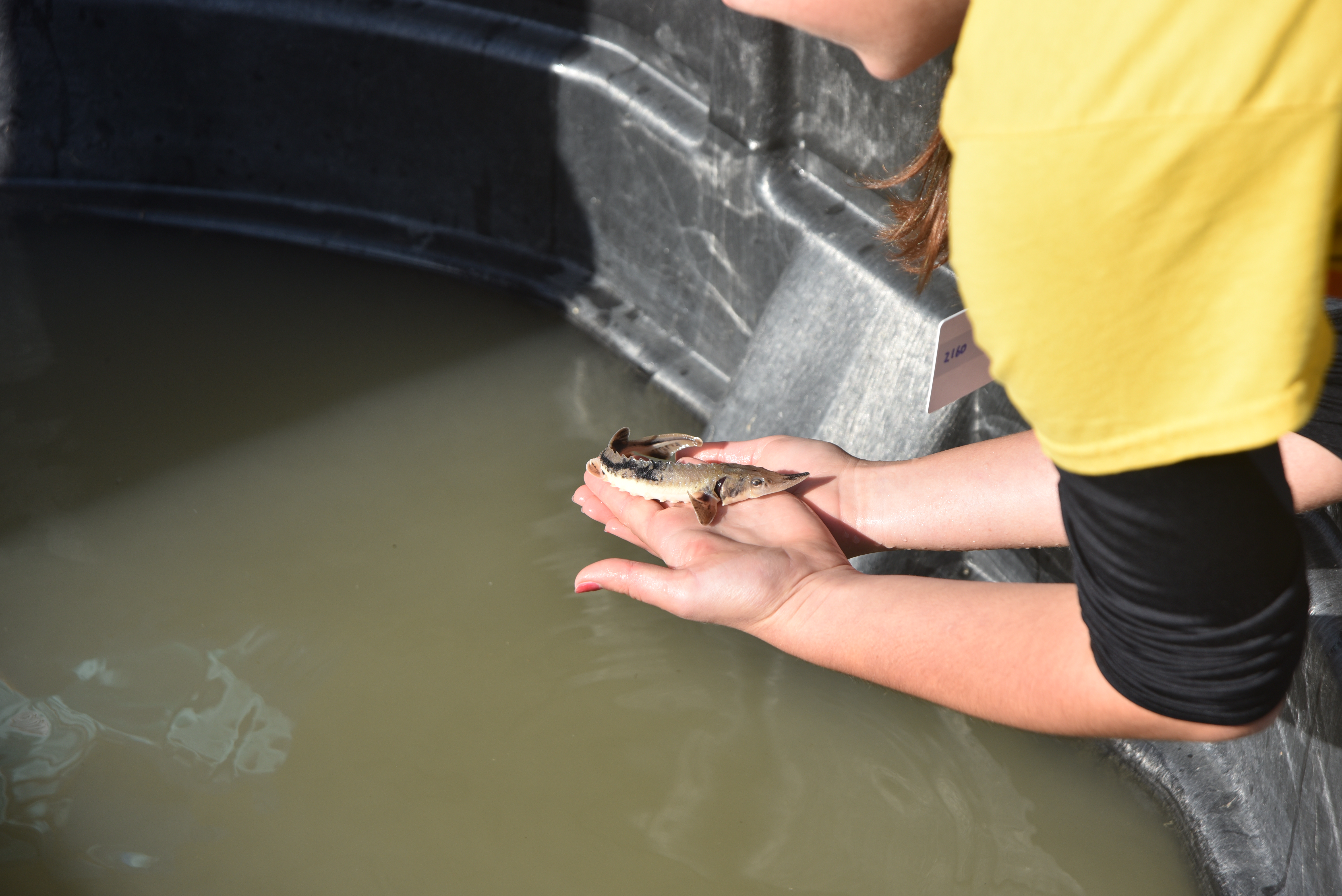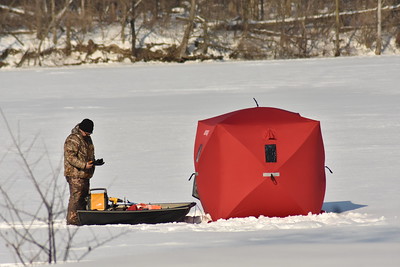
The Toledo Zoo’s popular lake sturgeon stocking event won’t happen this year, though a pause in the program – thanks to the international COVID-19 pandemic – won’t hurt the project.
“In a nutshell, our partners out of the U.S. Fish and Wildlife Service in Alpena, Michigan, and Genoa, Wisconsin, are the ones who collect the eggs,” explained Kent Bekker, director of conservation at the zoo. “Due to travel restrictions with the USFWS and closures at the Canadian border, we were unable to collect eggs.”
Bekker said the project, slated to stock 3,000 lake sturgeon in the Maumee River each autumn for the next two decades, will continue – just not this year.
“We’re committed to this project long term,” Bekker said. “It’s just that this one year is unfortunate because we really enjoy the opportunity to reach out to people and help sturgeon and the recovery effort on Lake Erie.”
The project, which uses eggs taken from fish in U.S. and Canadian waters, produces sturgeon at two hatcheries. One is at the USFWS hatchery in Genoa and the other at a specially constructed hatchery at the Toledo Zoo. The Toledo site circulates Maumee River water through the small hatchery, located inside a trailer near the riverbank.

A group of outdoor writers tour the USFWS Hatchery in Genoa, Wisconsin. (Photo by James Proffitt)
All the fish are released into the Maumee River in Toledo at an event that has drawn thousands between the first two stockings in 2018 and 2019. The release of sturgeon includes the opportunity to name and track an individual sturgeon released. While naming and tracking a sturgeon costs a small fee, anyone can release a sturgeon. Each tiny, 7- or 8-inch fish is fitted with a tiny electronic tag, allowing it to be scanned in the future for data collection.
The lake sturgeon is a prehistoric creature which hasn’t changed much in millions of years. They can grow to lengths of up to 8 feet and live well over a century. They’re considered benthivores, meaning they spend their time swimming on the bottom and sucking up worms, mollusks and other tasty morsels from the mud and muck. In Ohio they’re listed as an endangered species, and in Michigan a threatened species. The fish are currently listed as threatened in 19 of the 20 states they inhabit.
In February several environmental groups in Illinois and Indiana filed a federal complaint in hopes of forcing the USFWS to complete a review that could designate lake sturgeon as a federally endangered species. Unfortunately, there is a backlog of such reviews for other species awaiting status determination. Officials say it could take several years to clear up the awaiting reviews.
Sturgeon have many friends in Michigan
Sturgeon for Tomorrow is a nonprofit group whose goal is to help grow the population. Its methods vary, though two stand out: education and outreach.
“The Sturgeon in the Classroom program is something we advocated for early on in our strategic planning for the organization. These fish can live to be 150 years old, and we’ve been at this for just 25 years, so we’re just now beginning to see the fruits of our labor,” said Brenda Archambo, president of SFT Black Lake Chapter. “We think it’s incumbent upon us in terms of conservation leadership to reach out to the next generation of potential stewards, so that’s why we advocated for this.”
The program lands a tiny sturgeon in classroom aquariums all around Michigan. Students learn about the fish, care for the fish, and when it’s time participate in their release. And that’s often a difficult task.
“When we get our fish into the classrooms in the fall they typically raise the fish until spring, then they bring the fish in to release them,” Archambo said. “That’s a very emotional proposition in that some of the students really do attach with the animal. Having them in the classroom is an exclusive opportunity.”
By having students care for and learn about the sturgeon, the program produces both more sturgeons for the ecosystem and advocates for that system.
“Hosting and caring for the tiny sturgeon for a school year helps build an affinity for Michigan’s natural resources not only for the sturgeon itself, but also the Great Lakes watersheds and their preservation,” Archambo said. “In the springtime when the sturgeon are in the rivers to spawn, we actually have an on-the-ground guarding program. People still poach these fish.”
Archambo said students involved in SFT programs often end up in science and conservation roles. One former volunteer who spent time guarding the big fish in the shallows is still looking out for wildlife and violators.
“We have a conservation officer in Presque Isle County, he started out as a sturgeon guard and is one of the success stories of our outreach and education programs,” she said.
Despite their odd appearance and the bony external plates called scutes, sturgeon have at times in American history been a prized fish for their meat and caviar.
“It’s a delicacy, though in Michigan the limited sport fishery is mostly catch-and-release,” Archambo said.
Each January the Black Lake Sturgeon Shivaree is held. The big fish party raises money for research, hatchery operations, education and outreach programs.
“It’s an event that was started back in the ‘60s to celebrate our sturgeon because we love them so much,” Archambo said.

Hundreds of tiny sturgeon at the USFWS Hatchery in Genoa, Wisconsin. (Photo by James Proffitt)
Some sturgeon will attend class
Michigan Department of Natural Resources biologist Thomas Goniea runs the program which hooks up some Michigan school classrooms with sturgeon, in conjunction with SFT. He said the Sturgeon in the Classroom program will continue this school year, though it will look different than last year’s program. Some districts have decided to forego the program this year and will resume the next year.
“The programs are coordinated by the SFT chapters, so they’re actually the ones who get the schools and sponsor the aquariums, delivering fish and developing curriculums,” he said. “But there are obviously districts where schools are not planning in-person classes right away and others that will have limited in-person classes to begin with.”
One chapter will take its sturgeon and, using online platforms, develop a program for remote sturgeon learning, Goniea said. Another chapter has decided to continue the traditional program, where sturgeon are kept in classroom aquariums and cared for by staff and students, with districts still interested in doing so and where students will be onsite.
“We’re going to have a smaller program this year overall, maybe in the range of seven to nine schools total,” he said. “There’s usually in the neighborhood of 20 to 22 schools.”
The bottom line, Goniea said, is that the program will still be providing important lessons about Michigan’s lake sturgeon and its environment this school year.
Maumee sturgeon begin offering insights
After just two years of Maumee River stocking, the tiny sturgeon released are offering scientists a glimpse of their lives, said Christ Vandergoot, director of the Great Lakes Acoustic Telemetry Observation System. The scientific data-collecting network was established by the Great Lakes Fishery Commission about 10 years ago.
“Our network of researchers uses acoustic telemetry to monitor the movements of fish across the Great Lakes Basin, and there’s all types of fish, not just sturgeon,” he said. “Basically what we found, in short, is that the majority of the released fish moved out of the Maumee within 30 days of release.”

Before the young sturgeon are released into the wild, USFWS staff fit each one with a PIT tag in order to gather scientific data one day in the future. (Photo by James Proffitt)
Vandergoot said about 40 of the tiny sturgeon were fitted with acoustic transmitters in both 2018 and 2019. The tiny devices, implanted beneath the skin, send out a unique radio signal to any of the hundreds of electronic receivers found anchored to the Lake Erie floor, which the fish pass near. The remaining 5,900-plus sturgeon were fitted with PIT (passive integrated transponder) tags, enabling researchers, commercial fishermen or others to scan a sturgeon with a handheld wand to detect the tag and enable scientific data collection.
“There was some fraction of the population that stayed within the river. The other fish, we’ve been detecting those fish as far as the eastern edge of the Western Basin, on the receivers out there,” he said. “We were able to track them pretty well when they were in the river, but once they got into the Maumee Bay and into the main lake it’s a little harder to keep tabs on them because their tags are so small. We saw some along the Michigan shoreline and some on the Ohio reefs.”
According to Vandergoot, the home ranges of the released fish may end up not being so great as walleye, which often travel the entire length of the lake. And information about mortality rates and whether predation of released fish is an issue could be forthcoming, too.
“That we don’t know, but we’re trying to get at that. If you take a look at those things, they don’t look so good to eat (to other fish) because they’re kind of skinny and bony and they have their sharp scutes, but no one really knows that,” he explained. “I think one of the biggest things is that we were able to successfully tag these things. They survived the process and now we’re able to use actual data to understand how these fish are behaving once they get out into open water. We’re really looking forward to what the data is going to tell us here in the upcoming years.”
Read more news on Great Lakes Now:
Intersecting Crises: Fighting for climate justice in a pandemic
In a time of COVID-19, millions of Americans are plagued by water debt
Offshore Decline: Great Lakes fish populations at risk from low nutrient levels
Total Maximum Daily Load: Court case looks to push for Ohio EPA nutrients limit for Lake Erie
Message to 2020 Candidates: Focus on water quality in Great Lakes states
Featured image: A tiny sturgeon patiently awaits its release into the Maumee River, (Photo by James Proffitt)




